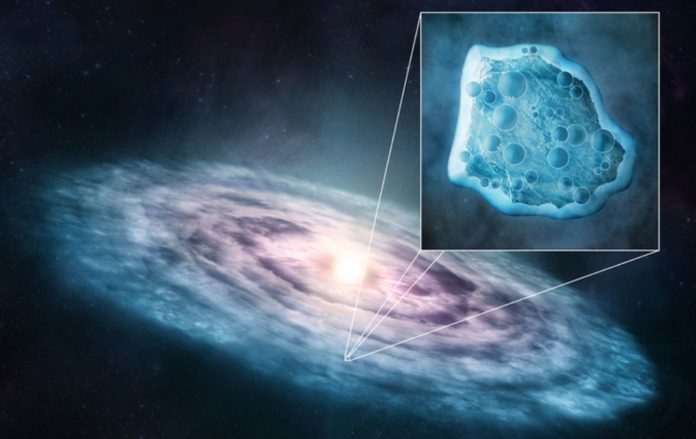Carbon monoxide is regularly observed in planetary nurseries by astronomers. The compound is very bright and very common in protoplanetary disks, which are dusty and gaseous areas around young stars where planets form. This makes it a prime target for scientists.
But, says Diana Powell, a NASA Hubble Fellow at the Center for Astrophysics | Harvard & Smithsonian, something hasn’t made sense with carbon monoxide observations for the last ten years or so.
If astronomers’ current projections of its abundance are accurate, a large portion of carbon monoxide is absent from all observations of disks.
A new model, supported by ALMA observations, has shown where the carbon monoxide has been hidden all this time: as ice crystals deep within the disks. Today, the results were published in the journal Nature Astronomy.
“This may be one of the biggest unsolved problems in planet-forming disks,” adds Powell, who led the study. “Depending on the system observed, carbon monoxide is three to 100 times less than it should be; it’s off by a really huge amount.”
And mistakes in measuring carbon monoxide could have huge effects on the field of astrochemistry.
Powell notes that carbon monoxide “essentially used to trace everything we know about disks — like mass, composition and temperature.” This could imply that many of their findings regarding disks were inaccurate and biased since “we don’t understand the compound well enough”.
Powell, intrigued by the riddle, donned her detective hat and relied on her knowledge of physics underlying phase shifts — when matter transforms from one condition to another, such as a gas becoming a solid.
To better understand clouds on exoplanets (planets outside our solar system), Powell tweaked an existing astrophysics model.
“What’s really special about this model is that it has detailed physics for how ice forms on particles,” she adds. “So how ice nucleates onto small particles and then how it condenses. The model carefully tracks where ice is, on what particle it’s located on, how big the particles are, how small they are and then how they move around.”
Powell used the modified model to study planetary disks in order to learn more about how carbon monoxide changes in planetary nurseries over time. Powell then compared the model’s output to actual ALMA observations of carbon monoxide in four well-researched disks: TW Hya, HD 163296, DM Tau, and IM Lup to assess the model’s viability.
Powell says that both the results and the models worked very well.
The new model fits all of the observations, which showed that the carbon monoxide wasn’t really missing from the four disks; it had just changed into ice, which a telescope can’t see.
Carbon monoxide can be seen in space as a gas thanks to radio observatories like ALMA, but ice, particularly massive ice formations, is considerably difficult to spot with existing technology, according to Powell.
Contrary to what was previously believed, the model demonstrates that carbon monoxide is indeed developing on massive ice particles, especially after a million years. Gaseous carbon monoxide is prevalent and identifiable in disks before a million years.
“This changes how we thought ice and gas were distributed in disks,” Powell says. “It also shows that detailed modelling like this is important to understand the fundamentals of these environments.”
The NASA Webb Telescope may be powerful enough to ultimately identify ice in disks, but that is yet to be seen. Powell hopes that her model may be further verified using data made with this telescope.
Powell says she is in awe of the influence of phase shifts and the intricate procedures that go into them.
“Small-scale ice formation physics influences disk formation and evolution — now that’s really cool.”
Image Credit: Getty
You were reading: New Scientific Evidence Changes Everything We Know About The Planet-forming Disk
